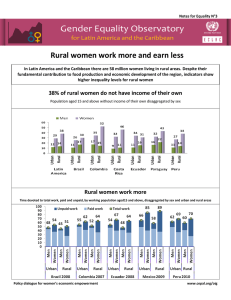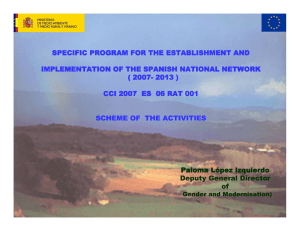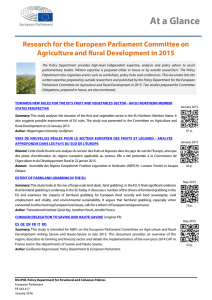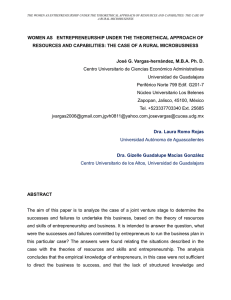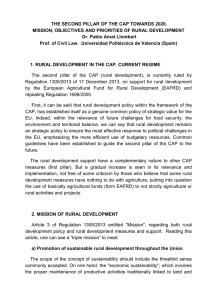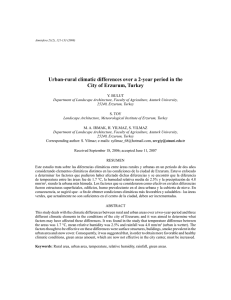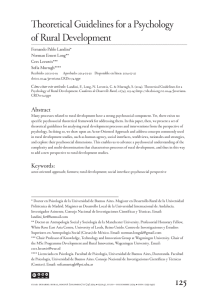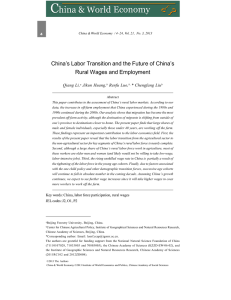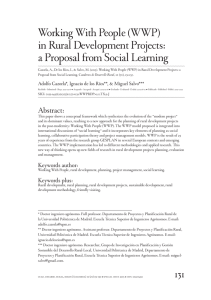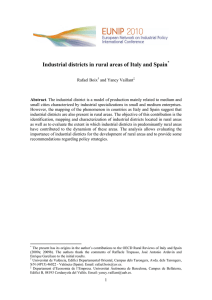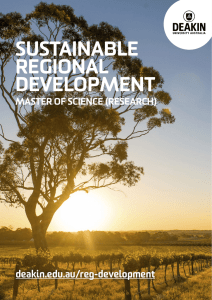Secondary education in rural areas: relevance - unesdoc
Anuncio
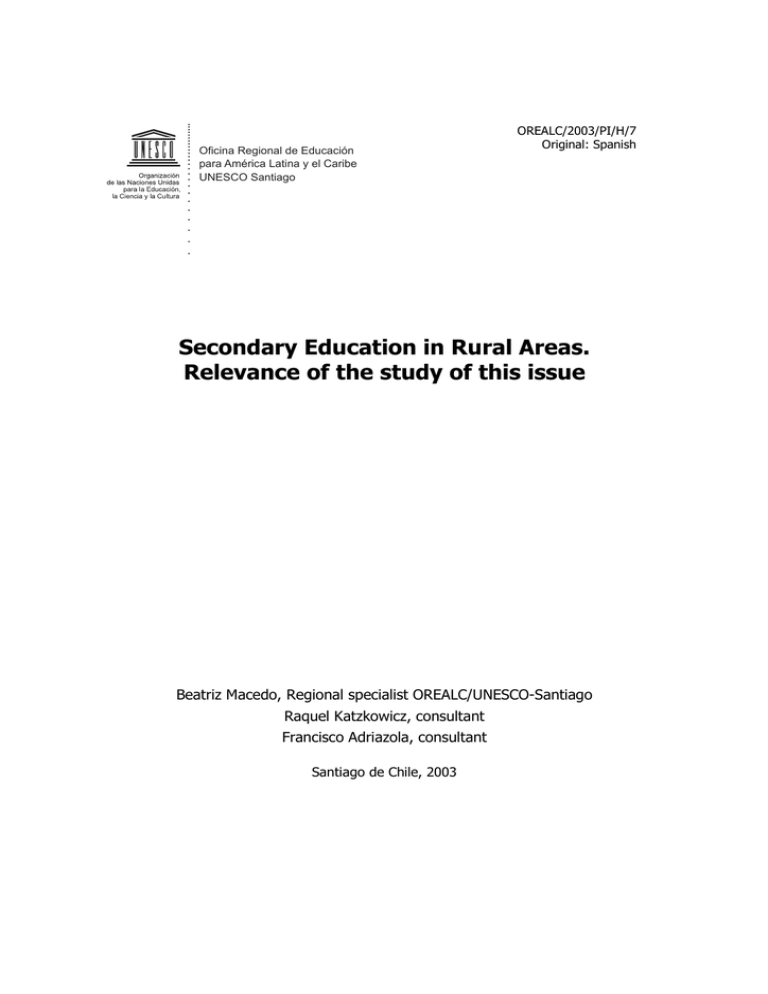
Oficina Regional de Educación para América Latina y el Caribe UNESCO Santiago OREALC/2003/PI/H/7 Original: Spanish Secondary Education in Rural Areas. Relevance of the study of this issue Beatriz Macedo, Regional specialist OREALC/UNESCO-Santiago Raquel Katzkowicz, consultant Francisco Adriazola, consultant Santiago de Chile, 2003 Secondary Education in Rural Areas Relevance of the study of this issue Beatriz Macedo Regional Specialist OREALC/UNESCO-Santiago Raquel Katzkowicz Consultant Francisco Adriazola Consultant In some Latin American countries there is reasonable coverage of basic, or primary education in rural areas. This statement cannot be generalized, however, since if anything characterizes this region it is its heterogeneity. But, when we look at the question of secondary education, the situation is quite different. In Latin American rural areas, young people lack real opportunities to allow them to continue their personal development and to prepare for the workplace. The high secondary school coverage and drop-out rates are indications of the lack of meaning that students find in curricular content compared to the realities of their environment. Moreover, the problem is linked with a significant exodus of the younger population from rural areas and the resulting decrease of school enrollment at this level. Education is important in the development plans of rural communities. Such planning involves an interaction with other specific factors directed toward a common objective - to decrease the marginalization of these communities and the avoid movement of the population toward urban areas in search of better living conditions. In most countries, this results in the creation of belts of poverty around urban centers. Moreover, in many of the countries of the region, rural areas are populated with native peoples who, in general, are deprived of essential services, including education. All of the above indicates that rural areas lack equal opportunities and are examples of the great inequalities that persist in our region. We ask ourselves, therefore: how is it possible to serve adolescents and young people in rural areas? It is essential that these adolescents and young people be provided with the same opportunities as their more privileged counterparts in urban areas. We should at the same time recognize that in urban areas inequalities exist and are reproduced in education services. This is a function of the social and economic class to which students belong, and is a situation that also needs to be reversed. We need to seek more adequate strategies in order to achieve quality secondary education for all. Secondary education in rural areas needs to effectively contribute to improving the living conditions of rural families. It needs to participate, as a part of the education system, in efforts to reverse the complex structural etiology of rural migrations, making it possible for rural men and women to remain and to develop in their own settings, but without predetermining that they do so. Any proposal for rural secondary education must, in our judgment, provide for a nationally- valid learning experience while at the same time being highly contextualized to conditions found in rural areas. Characteristics of rural secondary education in the region In approaching this theme we first present some background information about the general state of education in rural areas in Latin America. In the year 2000, the rural population of the region represented slightly more than 20% of the total population. Within this segment, 63% lived below the poverty line during the 1990s. The average number of years of schooling is 5.2 which practically leaves aside secondary education1 . Drop-out rates in secondary education are quite high 2 with only a small part of the population completing secondary school. Drop-out and grade repetition rates are much higher among the poor and those living in rural areas. Thus, in Brazil, for every 100 children of the 25% poorest stratum of the population, 45 drop out or repeat grades. For the wealthiest stratum this figure is 9%. For the region, heads of household of the 10% wealthiest stratum of the population have an average 12.1 years of education. In contrast, heads of household of the 30% poorest stratum have an average of only 5 years of education. Thus, there is a 7.1 year gap. The figure is 9 years in Mexico, and 8 to 9 in Brazil, Panama, and El Salvador. Perhaps the most palpable expression of one of the causes of poverty is the inequality reflected in differences of opportunity to education, and in the notorious differences in the quality of education offered. In general, public schools, which are attended by children from poorer families, are extremely limited. The deterioration that has taken place in many cases in terms of investment in buildings, maintenance, modern education media, and salaries has placed them in a very disadvantaged situation. It is estimated that in private schools, children receive 1,200 hours of class annually, in urban public schools 800, and in rural public schools 400 hours. The processes of school dropout, grade repetition, and the gaps in quality produce education systems which, in spite of efforts, are extremely unequal. The areas classified as rural in the region possess unique features, even within countries. Multi- lingualism and different social and economic characteristics add to the difficult task of offering quality education to all inhabitants of these areas. Generally, one Nearly 50% of the children who enroll in primary school do not finish the cycle. An IDB analysis (1998) of the situation in 15 countries of the region showed that for every 100 children enrolled in the first grade in Bolivia, Brazil, Colombia, and Peru, only 15 finish 9 years of schooling. 2 In Bolivia, for example, only 22.5% of rural young people finish secondary school. In urban areas the figure reaches 60.9%. In Peru, 12% of rural young people finish secondary education. 1 may say that it is these cultural differences that has marked the complete failure of the education systems that have been applied. Undoubtedly, concern about rural areas is a result of the obvious situation of their underdevelopment This is the case throughout the continent; there are no cases of countries that present equal conditions of treatment and opportunity between rural and urban areas. In this sense, education is one more aspect of this eternal reality. The data that we have analyzed (for coverage and drop-out) in general, show that conditions are much more deficient in rural areas, either compared with urban areas, or measured in terms of quality. Thus, for example, in Bolivia, only 30% of young people in rural areas attend secondary school. Only in Chile does coverage surpass 50% (76.8%). According to available information, secondary education in rural areas is largely of the technical variety. In practically all of the countries consulted, we find descriptions of education courses designed for the rural population (which are not always implemented in such areas, and on occasion are more an expansion of urban education than clearly contextualized programs for the rural sector). A number of programs have been carried out that have as a common denominator the need to fit education to the cultural, economic, and social standards of the location where such education takes place; that is, rural projects seek to deal with the disarticulation of educational offerings, with the specificity of life-skill needs and development of the population in rural areas. All of the programs studied demo nstrate a close relation between the settings in which the students live, thus influencing the educational process and its results. The predominance of technical instruction within rural areas is a response to the particular characteristics of the setting; that is, to the type of economic activities carried out there, to seasonal calendars, the recurrent lack of education of parents, the distance of certain localities, among others. In regard to the opinions of parents in regard to the importance that they give to the education of their children, it has been seen that one of the difficulties in rural areas is the perception of parents that, once certain basic skills such as reading, writing, and certain mathematical operations have been mastered, the child can leave school. A program that seeks to correct this perception, being carried out in Peru, is called "School of the Air". It consists of the production and dissemination of radio programs directed at parents and other educators of children. The program content deals with early childhood education and the diffusion of the emergence of education. These characteristics of the rural setting have been considered by special programs that work in conjunction with rural secondary education. Thus, in Colombia, for example, there are "Living Quarters and Rural Schools" with a number of specific features. "Juvenile Rural Residences", besides treating the problem of homelessness, provide young people with technical training for rural tasks and foster positive attitudes and values for rural living, stimulate citizen solidarity and self- management through the development of a non- formal curriculum applied to the specific conditions of the rural setting. Another advantage offered by rural residences for young people is that they offer a solution to the problem that parents have in sending their children to school, whether due to the cost involved or because often, young people represent an important source of labor in rural settings. The Juvenile Rural Residences offer social and technical training aimed at seeking solutions for the satisfaction of human development needs. Technical agricultural training based upon the Self-Sufficient Comprehensive Farm model (GRANIA) provides the opportunity for young people to acquire basic economic knowledge based on sustainable agricultural production. This model brings together social and technical-economic components within the principles of energy, environmental, and food production sustainability. Juvenile Rural Residences become centers of social development, producing technologies and strategies to solve community problems using inter-institutional coordination and the active participation of the rural population. The infrastructure and physical, human, and technical resources provided make these activities possible. In Chile, the "Schools for All" program establishes rural schools as a fundamental element for increasing the coverage of secondary education. In order to solve problems of the agricultural calendar, related normally to the type of production in rural areas, many of which are of difficult access, programs have been developed such as that created in Peru called "Alternative Rural Training Centers". These seek to offer secondary education to young people and adolescents in distant rural areas and alternate periods of study, combining study within a rural school and gainful employment in these communities. This kind of experience is an alternative that makes secondary education accessible to young people and adolescents in rural areas. A similar program is that called "Post-Primary" in Colombia, which offers a flexible curriculum which may be adopted to diverse conditions. In order to approach the problem of meaningfulness of curricular content - and solve the problem of the lack of articulation of educational offerings with the specific needs of the setting - programs have been created such as the Rural Schools and Education Centers in Uruguay in which the curriculum is focuses on specific areas and includes activities adapted to the setting. Often cited when discussing rural-based education is the "Mexican Rural TeleSecondary" program which was created in 1970. This consists of "a school modality of the Mexican educational system that provides secondary education to young people who live in small rural communities that are far from urban centers and where it is not economically feasible to create general or technical secondary schools. While pursuing the same educational objectives and offering the same curriculum as other modalities, they differ in their form of operation, organization, and the teaching resources that they use"3 . This educational model brings together features of formal and distance education, mixing the use of television as an educational tool, as well as printed material that fosters student self- learning and under the supervision of a teacher who certifies student attendance and hours studied. Growth of this modality is responsible for almost one-half of the growth 3 "A view of the efficiency and equity of Telesecundaria Mexicana" p.1 Mexico, November 8, 2002 of Mexican secondary education; 47 of every 100 students entering secondary education in Mexico from 1993-2001 did so through this program. 4 Given that this educational model has experienced an explosive growth, it has emphasized improvements in overall rates of grade failure and course termination (which are quite positive, even when compared with general and technical secondary education) while tending to leave aside those referring to student achievement levels. These programs have been important from the point of view of those for whom these models have been designed; that is, their creation has sought to satisfy the education needs of the most underprivileged sectors of the population. However, measurement of their achievements should be based upon their ability to equal the opportunities offered by other types of secondary programs. We have described above some of the experiences that currently are being carried out in Latin America that seek to remedy the disadvantages position of rural communities. This report has not offered detailed figures. The objective has been to show in a succinct manner the ways that the rural secondary education issue is being approached. We wish here to offer some comments regarding rural secondary education. First, it is quite evident that societies progress according to the cultural capital that they possess. In this sense, agricultural production is increasingly influenced by new technologies, the international market, and other factors. These facts attest to the growing need to provide young people with the knowledge and skills that permit them to develop within this framework. Technical education has filled this role, providing young people enrolled in secondary school with resources to work within this setting. However, certain features have long persisted in the rural context that lead us to question the current education model. Witness the fact that migration from the rural setting is still viewed as the best option for achieving social mobility. In this regard, the phenomenon of rural to urban migration increased continually during the XX century. As we begin a new century the phenomenon continues, due primarily to industrialization and new kinds of land ownership (that have operated through large land-holdings, and currently through the appearance of cooperatives and a decrease of small land-holdings). This situation leads us to think that rural secondary education must prepare young people to successfully integrate themselves into both environments - a concept that to an extent goes against the predominance of technical schools in the rural setting. One notes that there is an aspect of rural secondary education that in a sense, relegates to a secondary plane citizenship training and the need to make rural dwelling students active participants of societies that are increasing global and increasingly changing. In 2002, one-fifth (1,096,637) of secondary school students were served in more than 15,000 Telesecundaria classrooms. Annette Santos del Real, " A view of the efficiency and equity of Telesecundaria Mexicana" " Nov ember 8 de 2002 4 Among the objectives of UNESCO is that of achieving quality education for all (education with quality and equity), allowing adolescents and young people of the region to fully develop their potential so they may be prepared to construct a more just society with sustainable development and peace. The concern to improve the situation of rural secondary education treats a subject the urgency of which should not lead us to once again use strategies that have proven to be inefficient in the past. In order to successfully provide quality secondary education for young people living in rural areas, it is essential that the necessary human and material resources be available. In this sense, it is very important to make use of the Secondary Education Forum and the Secondary Education Observatory which contain a network of specialists, researchers, and decision- makers in this area.
